
* After the Viking probes, Mars exploration went idle for almost a decade. Beginning in the late 1980s, however, space probes began to fly to the Red Planet again, though with mixed results.
* The Mariner and Viking probes so greatly expanded knowledge about Mars that the ideas about the planet that had prevailed before the space age now seem embarrassing.
The biggest disillusionment was that the canals did not exist: they had been a complete fantasy. When detailed maps obtained from the Mars probes were overlaid with the old pre-spaceflight maps, there wasn't even any correspondence between the canals and actual surface features. The "wave of darkening" reported in the Martian spring was also an illusion. The planet's dark areas were not seas or regions of vegetation, just basaltic plains.
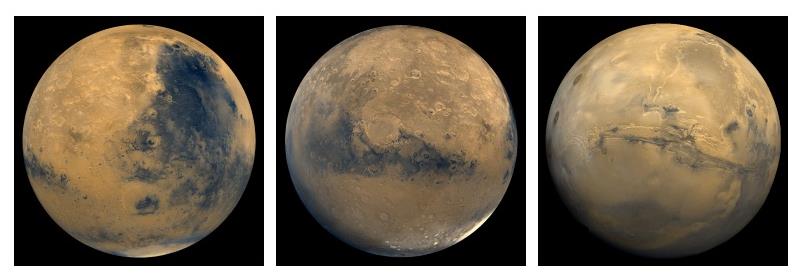
In fact, the images returned by the Mariner flyby probes had been a shock of sorts, since they suggested was that Mars was a thoroughly dead and uninteresting world. It was a relief when Mariner 9 and the Viking orbiters provided a fuller view of the planet that showed it to be much more lively, at least in the geological sense. The terrain seemed to show evidence of flooding and volcanic activity, though when it had occurred was anyone's guess, with estimates ranging from tens of millions to billions of years ago.
It had been obvious in pre-spaceflight days that the northern and southern hemispheres of Mars were generally different in appearance. On close inspection, the southern hemisphere turned out to be littered with impact craters, and has a generally higher elevation than the northern hemisphere. The northern hemisphere has more varied terrain, including the great Valles Marineris canyon, many channels, large and relatively featureless plains, and huge volcanoes such as the towering Olympus Mons.
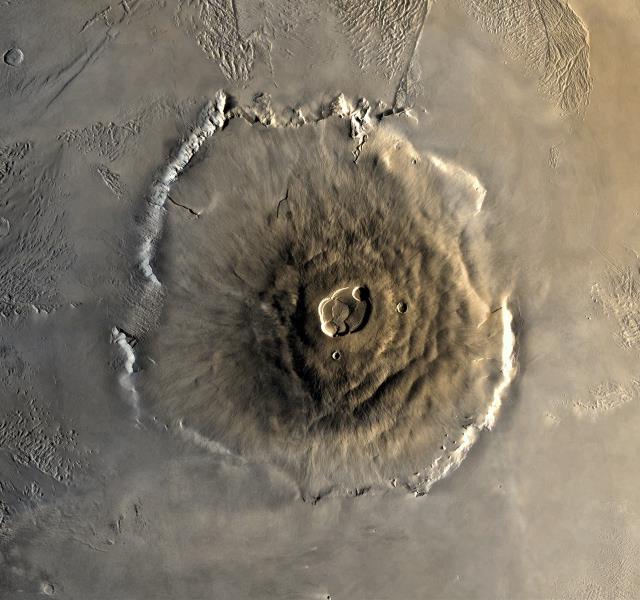
Mars can be divided into north and south polar regions, and four planetary "quadrants" between those polar regions:
* The two Viking landers reported a very chilly and dry planet, temperatures ranging from about minus 15 to minus 140 degrees Celsius. Mars is a very windy place; wind speeds are normally about 7 KPH, but during the great planetary dust storms, which occur in the spring, the winds may reach up to 80 KPH. Surface features on Mars often show unmistakeable evidence of wind erosion.
The dust is thick almost everywhere and is very fine, with the consistency of flour. The soil analysis performed by the landers showed the surface around the landing sites to have a hundred times more sulfur than in terrestrial or lunar soil. The planet's brightest areas, excluding the icecaps, are also the dustiest.
The atmosphere is 95% carbon dioxide, about 3% nitrogen, 2% argon, plus traces of other gases. The concentration of water vapor is only about 0.016%, but interestingly clouds can still be observed on occasion, such as those that stream off the tops of the great volcanoes like Olympus Mons. These clouds may contain dry ice crystals as well as water. Atmospheric pressure at mean ground level is only about a hundredth that of Earth's atmospheric pressure at sea level, and the pressure can drop by up to 25% in the winter, when carbon dioxide freezes out of the atmosphere onto the north polar icecap.
* Ideas about the internal composition of Mars remain generally speculative, since so far none of the landers have carried experiments that could provide much useful information about the planet's interior. The Red Planet is believed to have a thicker crust than that of the Earth, and an iron-nickel planetary core. The lack of a significant Martian magnetic field suggests the core is solid.
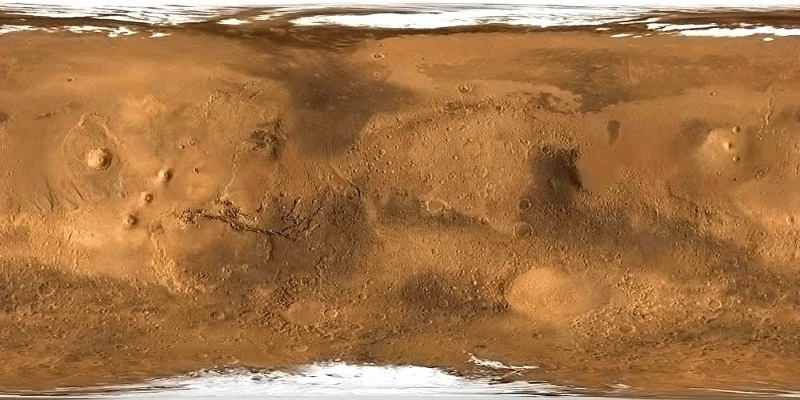
Unlike Earth, Mars does not have plate tectonics; the entire crust of the planet is essentially one piece. This is why the Martian volcanoes are so big. On Earth, a hot spot near the edge of a continental plate erupts through the crust to form a "shield" volcano, but the moving plate moves one volcano off the hot spot, leading to the formation of another volcano, until a chain of volcanoes has been constructed. This was how the Hawaiian Islands were formed. On Mars, a hot spot stayed in one place and continued to build up one huge volcano.
* The Viking observations also provided many new details of Phobos and Deimos, though as they had generally been correctly regarded as hunks of rock before the space age, there were no great surprises. Both moons are airless, dark-colored, and covered with craters. They are both tidally locked to Mars and so only one side of each moon is ever seen from the surface of the planet.
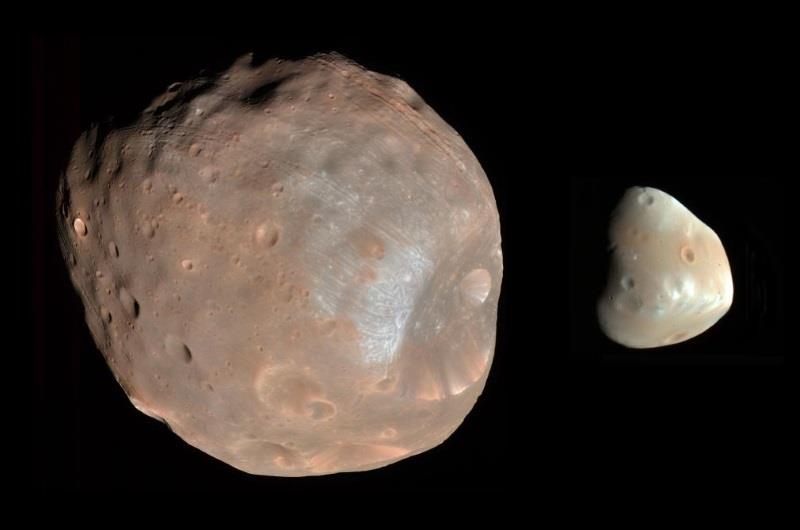
The largest crater on Phobos is named "Stickney", the maiden name of Asaph Hall's wife, who encouraged him to keep looking for the Martian moons when he was ready to give up. Phobos has a low density and possibly contains water ice. 21st-century recent observations by Mars orbiters show that its surface has a reddish color, like that of the Martian surface, suggesting that it has been coated by debris kicked up by meteorite impacts. Phobos has an extremely low orbit compared to any other moon in the solar system, and its orbital height is decaying by about 1.8 meters per year. It will break up into a ring or impact the Red Planet directly in about 40 million years.
In the early 1960s, a Soviet astronomer named Iosif S. Shklovskii deduced from the rate of decay of the orbit of Phobos that it was hollow and could be artificial, and suggested that the reason it hadn't been seen before 1877 was the fact that it had only recently been launched from Mars. Refined data quickly destroyed this theory, which had been an embarrassment to other Soviet scientists, and Shklovskii later claimed he hadn't been very serious about his proposal.
The two largest craters on Deimos are named Swift and Voltaire, and are both about 3 kilometers across. The surface of Deimos is smoother than that of Phobos, and is covered with a layer of loose regolith material. Like Phobos, Deimos has a low density and possibly contains water ice. Viking orbiter observations seemed to show the two moons were rich in carbon, suggesting a link to carbon-rich asteroids -- but as discussed later, these observations proved misleading.
BACK_TO_TOP* The Soviets were the first to return to Mars after the lapse in exploration activities. The USSR launched the "Phobos 1" and "Phobos 2" probes in 1988, which as their names imply were primarily intended to observe the Martian moon Phobos. These were very ambitious spacecraft, each with a launch mass of 6,220 kilograms, launched by heavy Proton boosters. They each carried 25 instruments, many from European partners, including:
Both probes carried a lander station, which was to attach to the little Moon with a harpoon system lest it float away. Its science payload included an APXS, a CCD camera, and a seismometer. Phobos 1 carried an imaging radar, while Phobos 2 instead carried a "hopper" with a spring-loaded catapult to hop around. It was the first but by no means the last hopper to be sent to one of the Solar System's small bodies.
Phobos 1 was launched on 7 July 1988. However, on 2 September a command was sent from the Earth control station by mistake, telling the probe essentially to shut itself off. The spacecraft's system software had not been designed to send back an: "ARE YOU SURE?" -- message as a doublecheck, and so the probe dutifully shut itself down, to be lost for good. The mysterious Ghoul could legitimately deny any responsibility. Phobos 2 was launched on 12 July 1988. The probe went into orbit and managed to return some images, before contact was simply lost on 27 March 1989, apparently due to an onboard computer failure.
* For the moment, the US wasn't doing any better. The first US spacecraft to be sent to Mars after the lapse was the "Mars Observer (MOB)" probe, essentially a modified Earth satellite that was to take extended observations of the Red Planet. It was launched on 25 September 1992 by a Titan III booster.
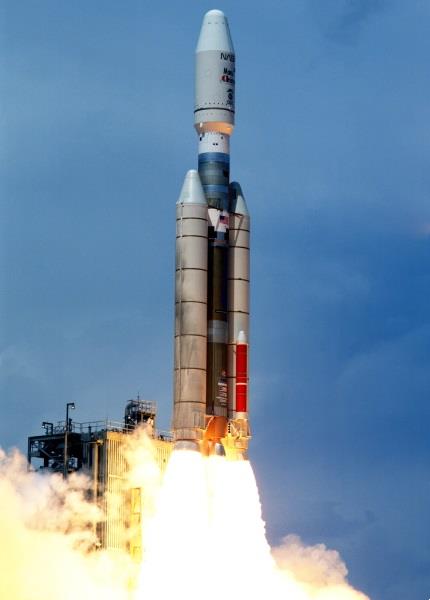
MOB weighed about 2.5 tonnes. The spacecraft was based on a communications satellite bus, with avionics systems inherited from civil and military weather satellites. An enlarged solar array was added, as well as propulsion systems for interplanetary flight and two long instrument booms. MOB carried eight payload systems, including:
It had a dual redundant microprocessor-based computer system, each processor with 128 kilobytes of RAM, and a dual tape data storage system, each drive with 187.5 megabytes. Unfortunately, MOB disappeared abruptly as it performed final maneuvers before going into Mars orbit in August 1993, apparently due to an explosion in its rocket system. Loss of MOB was a particular humiliation for NASA, since the post-mortem indicated serious faults in program management and spacecraft design.
BACK_TO_TOP* Despite the loss of MOB, NASA was by no means ready to give up on Mars exploration. There was a desire to replace the lost MOB mission in some way, and also growing international interest in Mars missions, with new ideas being discussed and considered. NASA came up with an ambitious program named the "Mars Environmental Survey" -- MESUR, pronounced "measure" -- that would use four Delta boosters to send 16 landers to Mars to establish a comprehensive Mars observation network. MESUR turned out to be far too ambitious and wasn't funded, but it provided a basis for more practical US Mars efforts. Two probes, an orbiter and a lander, were funded for launch in the 1996 Mars launch window.
The orbiter was the "Mars Global Surveyor (MGS)", launched on 6 November 1996. It carried a payload of six instruments and was intended to survey the atmosphere and surface of Mars for a full Martian year. The lander was the "Mars Pathfinder", which was launched on 2 December 1996. It carried a small six-wheeled rover named "Sojournor" to examine the area around the landing site. It was the first operational American planetary rover, and the first rover to operate anywhere but the Moon.
The Russians also launched a very ambitious Mars mission on a Proton booster on 16 November. Their "Mars 96" probe consisted of an orbiter with a payload of 22 instruments, most of which were provided by European participants, along with two small landers and a pair of surface penetrators to be dropped to the surface of the planet. Sadly, Mars 96 never left Earth orbit, with an upper stage failure dropping it into the Pacific Ocean or onto South America. It was a bitter blow to the struggling Russian space program, all the more so because the mission was lost due to a booster failure, and Russian boosters have an excellent reliability record. It was the last Soviet-Russian Mars probe of the 20th century -- most of the series having been complete failures, and only two of them even being partially successful.
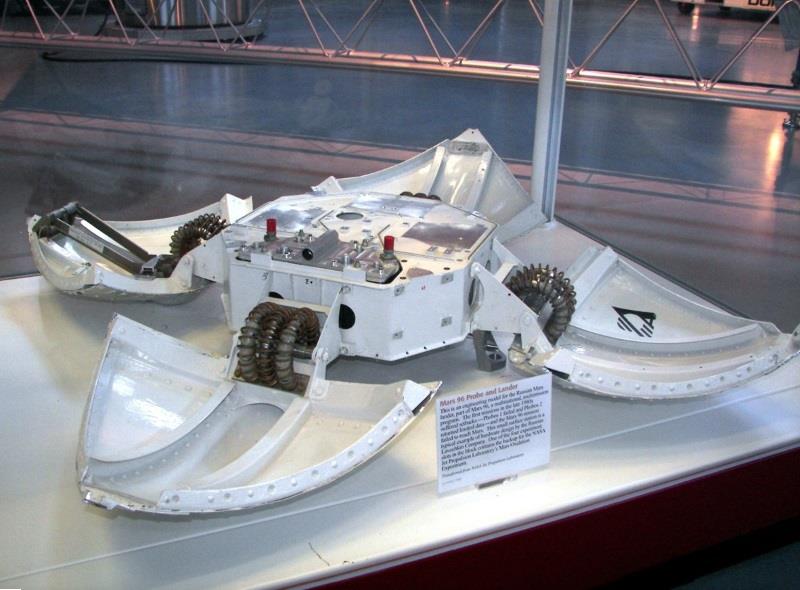
MGS and Mars Pathfinder were in contrast highly successful, both arriving in the summer of 1997 and performing splendidly. Although MGS did suffer a serious technical problem, the amount and quality of information returned by the probe was extraordinary.
* MGS was intended to make up for much of the science lost after the failure of MOB in 1993 using a low-cost mission. It weighed 1,060 kilograms, in comparison with 2,250 kilograms for the ill-fated MOB, and was launched by a Delta 7925 II booster instead of a Titan III. MGS was effectively a subset of MOB, with six of the eight instruments carried by MOB -- the imaging system, the laser altimeter, the thermal emission spectrometer, the magnetometer / electron reflectometer, and the Mars relay.
It had a dual-redundant microprocessor-based computer system, each processor with 256 kilobytes each, plus dual solid-state drives with 187.5 megabytes of storage each. Incidentally, thanks to the relay, the MGS became the founding element of the "Mars Relay Network" to support lander and rovers, with later orbiters becoming elements as well.
One of the ways in which MGS achieved lower cost and weight than MOB was the fact that it relied heavily on "aerobraking", skimming the Martian atmosphere in shrinking ellipses to circularize its orbit. Techniques for aerobraking were proven in concept during the final mission phases of the Magellan Venus orbiter, but MGS was the first spacecraft to be actually designed to use the approach. Its solar panels were hardened to allow them to tolerate erosion and heating from aerobraking maneuvers, and in fact had extensions on the ends of the panels to act as drag flaps.
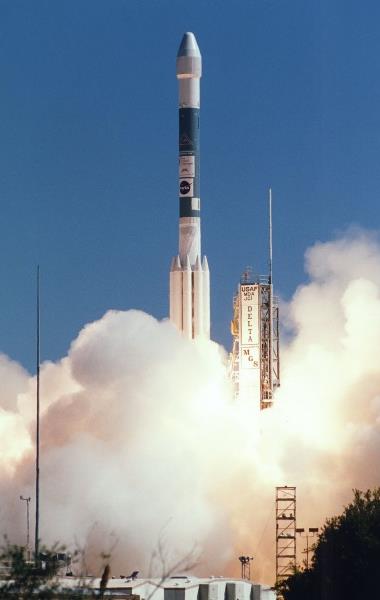
Unfortunately, the joint connecting one of the aerobraking solar panels to the spacecraft body was damaged, and the aerobraking maneuvers were stretched out a year longer to ensure that the joint did not fail completely. However, once MGS finally attained mapping orbit in February 1999, the spacecraft began to return a flood of information from the planet.
* MGS's primary science mission ended on 31 January 2001. Since the spacecraft was in excellent health, an extended mission was funded, and the probe was still operational in 2006, though by that time its performance was increasingly erratic. On 8 May 2003, MGS took advantage of a rare planetary alignment to image both Earth and Jupiter in a single frame, as something of a publicity stunt. The images were of course small and fuzzy, but computer enhancement was able to reveal some details.
As another interesting stunt, in the spring of 2005, MGS took some fuzzy images of two Mars orbiters -- the NASA Mars Odyssey Observer and the ESA Mars Express, both discussed later -- that had arrived in the meantime. It is not unusual for spacecraft in Earth orbit to image other spacecraft, this apparently being done on a routine basis by military satellites, but this was the first time it was ever done around another planet. Although the images did provide good publicity they had potential practical applications as well, since such images might be used to help troubleshoot a spacecraft that has malfunctioned.
MGS's mission finally ended in late 2006 after ten years in space, when a solar panel jammed and could no longer track the Sun. Contact was lost, which prevented ground controllers from boosting the spacecraft into a higher orbit. That was to be done because the spacecraft was not completely sterilized before launch. Mars exploration guidelines indicate that a non-sterilized spacecraft should not fall to the planet's surface for 50 years, when any organisms on board can be assumed to be safely dead.
* As for Mars Pathfinder, it was originally named "MESUR Pathfinder", and was to be the prototype for the MESUR landers. Although MESUR was not funded, the Pathfinder mission went ahead as a technology demonstration effort for other possible Mars projects.
Mars Pathfinder landed near the Martian equator on the 4th of July 1997, American Independence Day. Pathfinder had a launch mass of 890 kilograms, and was launched by a Delta II 7925 booster. The probe consisted of three main elements: an interplanetary cruise support stage, a Mars entry aeroshell, plus a tetrahedral-shaped lander enclosed inside the aeroshell and carrying the Sojourner rover.
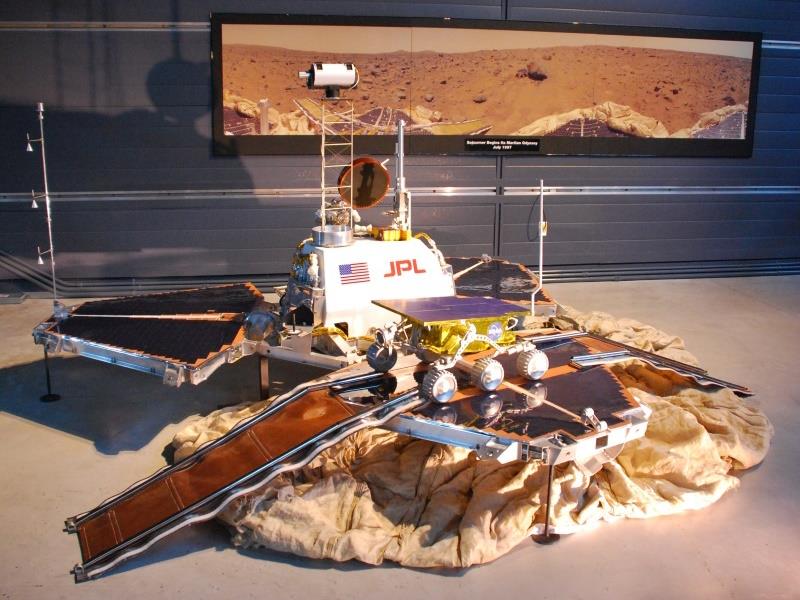
The cruise stage included propulsion, navigation, cooling, and electronics for the interplanetary cruise phase of the mission. To reduce cost, the cruise stage leveraged off lander electronic systems, such as processor and radio transmitter. This approach posed overheating problems with the packaged lander, and so the cruise stage added a cooling system to keep the lander systems under control.
The aeroshell was a flat cone, very similar to the design used for the Viking missions over 20 years earlier. The landing system was an entirely new scheme, based on airbags. The aeroshell entered the Martian atmosphere directly from interplanetary cruise. After entry, the aeroshell deployed a large parachute at high altitude, and blew away the heat shield with pyrotechnic charges.
The lander reeled itself down from the backshield on a long metal tape to give it room for the following descent operations. The lander took a few images of the terrain it was descending onto -- or tried to, the camera failed due to a software error -- then activated a radar altimeter to tell it when it was at the proper altitude for the final landing sequence. A few seconds before landing, the lander inflated the airbags, solid rockets on the backshield fired to kill the drop velocity, and then the lander cut itself loose to drop to the surface.
There were four airbags, each built as six linked 1.8-meter diameter spheres arranged like a rack of billiard balls, and with one airbag on each of the lander's four faces. The airbags broke the probe's fall and then a retraction system ripped them open, discharging them through a filter to keep them from contaminating the landing site. The deflated airbags were winched under the lander. The tetrahedral lander was built with three triangular "petals" attached to a triangular base. The opening of the petals righted the lander to expose the spacecraft's sensors and the Sojourner mini-rover. The petals were covered with solar cells to provide power.
The lander itself carried a stereo camera system with color wheel filters on a telescoping mast, and a meteorological package. The two cameras used a single common imaging CCD, being selectively routed to it via moving mirrors. The lander was controlled by a RAD6000 computer, with a radiation-hardened processor and 128 megabytes of memory. The RAD6000 was used on many probes and space platforms at that time.
After landing, it was named the "Carl Sagan Memorial Station", after the well-known American astronomer / scientific popstar. The Sojourner rover weighed 11.5 kilograms, had six wheels, and a solar panel on top for power. Its sole instrument was a Russian-built APXS, though it had stereo monochrome CCD cameras up front, and a single color camera in back. Computing power consisted of an 80C85 processor with less than a megabyte of memory. The rover wasn't intended for extended use; a dust storm could foul the solar panel and render the little rover inert.
The landing of the Pathfinder probe on 4 July 1997 was a major publicity coup for NASA, attracting a great deal of public interest in the weeks that the lander and rover operated. In fact, JPL worked with the Mattel toy company to produce a scale model of the Pathfinder that couldn't be manufactured fast enough to keep up with sales. Sojournor only lasted a week -- it was more of a demonstrator than anything -- while the lander was operational for 85 days.
BACK_TO_TOP* After the great success of MGS and Mars Pathfinder, NASA followed up with the launch of a second set of probes, also consisting of an orbiter and a lander. The "Mars Climate Orbiter (MCO)" was launched on 11 December 1998 and the "Mars Polar Lander (MPL)" was launched in January 1999, both by Delta II 7925 boosters.
MCO only carried two instrument systems, including a pressure-sensing infrared radiometer and a dual-camera CCD color imaging system. It had a RAD6000 computer and carried a radio relay to support lander communications. Like MGS, MCO was designed to aerobrake into Mars orbit. MCO's launch mass was about 620 kilograms.
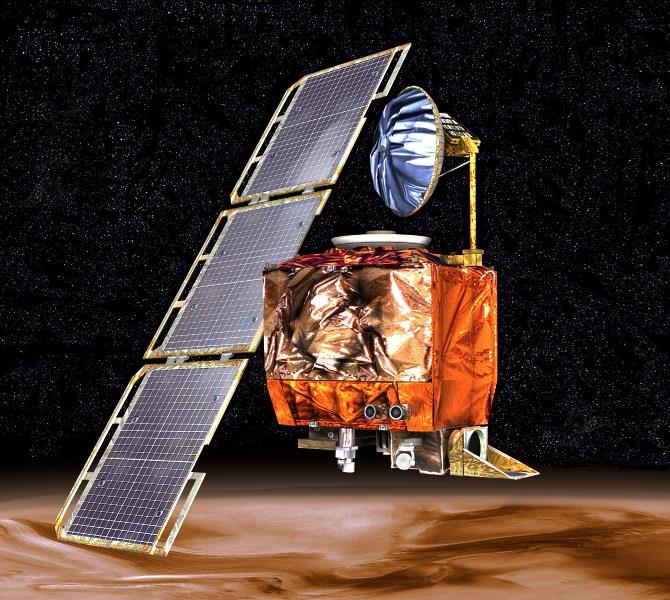
MPL had a configuration similar to that of a scaled-down Viking lander, instead of the airbag configuration used on Mars Pathfinder. Its instrument suite included:
In addition, it carried a microphone, contributed by the US Planetary Society, to allow Martian environmental sounds to be relayed to Earth. It also had a RAD6000 computer.
The lander was carried in a cruise stage very similar to that used on Mars Pathfinder and with the same aeroshell design. The lander weighed about 618 kilograms. MPL's cruise stage also carried two egg-shaped piggyback "microprobes" about the size of a basketball, designed under the NASA New Millennium program and named "Deep Space 2 (DS2)". The experimental DS2 probes were designed to be ejected by the cruise stage as it approached Mars to crash into the planet's surface and penetrate into the ground.
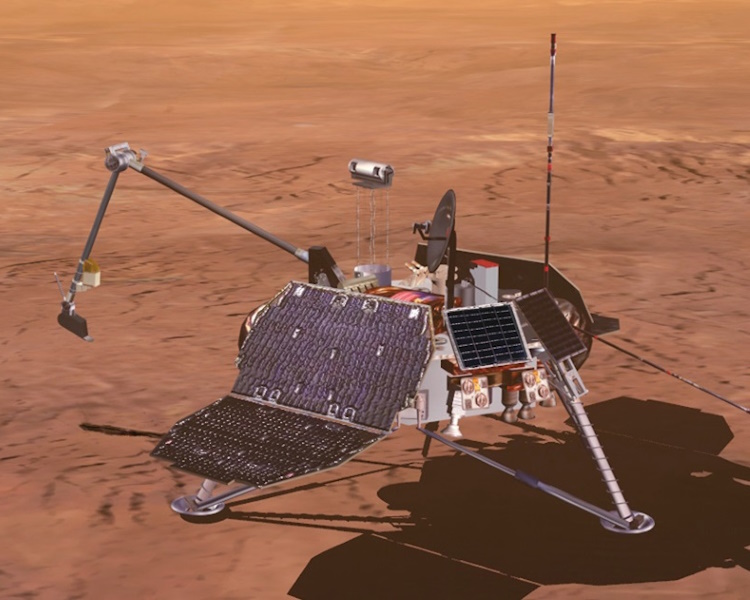
* MCO and MPL were part of an aggressive plan that involved Mars missions in the 2001, 2003, and 2005 launch windows, with the 2005 flight returning Martian soil samples to Earth. Unfortunately, NASA's good luck with MGS and Pathfinder was not repeated with MCO and MPL. Contact was lost with MCO on 23 September 1999. It was supposed to have skimmed the top of the atmosphere in an aerobraking maneuver to insert itself into Mars orbit, but there were errors in the flight software due to a mixup between English and metric measurements. It apparently entered the atmosphere and burned up.
The MPL probe went into its Mars landing maneuver on 3 December 1999, and promptly disappeared. Analysis suggested the most likely cause of the loss was a software glitch, in which a jerk in the spacecraft as it deployed its landing legs caused it to register zero acceleration. The spacecraft's control system assumed that it had landed and shut down the engines, sending the probe crashing into the Martian surface from an altitude of about 40 meters. The fact that MPL did not have the capability to relay flight telemetry during the descent, a design decision that was heavily criticized, makes this scenario little more than educated guesswork.
The loss of both probes was a public humiliation for NASA. American comedian Jay Leno announced a new book on his nighttime TV show, titled: MEN ARE FROM MARS, WOMEN ARE FROM VENUS, WHERE THE HELL IS MARS POLAR LANDER? The agency did the logical and indeed proper bureaucratic thing, establishing an independent panel to investigate the fiasco. The report issued by the panel suggested that the two probes were underfunded by as much as 30%. The Mars Global Surveyor and Mars Pathfinder probes cost about twice as much, and it seems that trying to cut costs much further, at least for one-of-a-kind spacecraft, was unrealistic.
Management of the project was strongly criticized. Testing and risk assessment were inadequate. In fact, the two simple Deep Space 2 microprobes that MPL ejected before entering the Mars atmosphere were judged by the report as so poorly tested as to be "not ready for flight", and the report did not bother to speculate on why they had failed. NASA responded to the problems by centralizing Mars efforts and streamlining management. Mars mission funding was not increased, since the money simply wasn't there, and the schedule for future missions was reconsidered.
* The US wasn't the only nation to send a probe to Mars in the 1998 launch window. On 4 July 1998, the Japanese "Planet-B" Mars orbiter was launched from the ISAS space center at Kagoshima on the island of Kyushu, using an ISAS M-5 solid-rocket booster. Once in space, it was given the name "Nozomi (Hope)".
The 540-kilogram Nozomi was Japan's first planetary probe, not counting two rudimentary probes sent on flybys of Halley's comet in the mid-1980s and discussed later. It carried a suite of 14 instruments, including:
Nozomi was placed in a highly elliptical Earth orbit, preparatory to sending it twice around the Moon and once back around the Earth to provide gravity assist for its interplanetary trajectory. This complicated exercise in celestial mechanics was required because the mass of the probe was too large for a direct trajectory, given the lift capacity of the M-5 booster.
Nozomi was to arrive at Mars in October 1999, but there was an error during near-Earth maneuvers that depleted the spacecraft's fuel supply to the point where it didn't have enough fuel left to put itself into Mars orbit. This was a disappointment, but mission controllers were able to attain a modified heliocentric orbit that performed two more Earth flybys to deliver the probe to Mars orbit in late 2003.
However, a solar flare damaged the spacecraft in the summer of 2003, and the mission was finally abandoned in early December of that year, just before Mars arrival, since the main engine was no longer operational, and there was no way to put the probe into orbit. There were some worries that the probe would crash on the planet and present a biological contamination hazard, but it missed by about 1,000 kilometers and went into solar orbit. It was a painful setback for Japanese ambitions in planetary exploration.
BACK_TO_TOP* There is a faction that believes the evidence for life once having existed or at least visited Mars is much more blatant. One of the more unusual legacies of the NASA Viking missions to Mars in the 1970s was a photograph taken by the Viking 1 Orbiter of a peculiar hill in the Cydonia region of Mars that, under some lighting conditions, looked like a human face. Viking project officials released the picture as a joke. Anyone who has ever watched clouds on Earth knows that by sheer chance they can have remarkable resemblances to faces or animals or whatever -- a phenomenon known as "pareidolia" -- and there was no reason to believe there was anything more than random chance at work.
However, a cult of sorts arose around the "Face", as it came to be known, with cult members claiming it was an artifact of a lost Martian civilization, and that a government conspiracy was performing a cover-up. Elaborate studies of nearby features proposed that the Face was part of a massive complex of structures, something like an outsized alien version of the Egyptian pyramid complex at Gizeh. Some Mars enthusiasts also pointed to the "Inca City", a set of rectangular squares jammed irregularly together found in a Mariner 9 image taken near the Martian South Pole in 1972, as evidence of a lost Martian civilization. Other photos released by NASA that displayed Martian features that looked like the Muppet Kermit the Frog and a giant "happy face" did not attract as much interest.
On 5 April 1998, the MGS took a high-resolution photograph of the Face from an altitude of about 440 kilometers. The photograph revealed, to the surprise of few, an eroded hilltop that might suggest a face to someone with poor eyesight or a good imagination. That would seem to settle the matter once and for all, but UFO enthusiasts and the like loudly protested on the Internet that the Face really did exist. Most prominent of the advocates was writer Richard Hoagland, who insisted that the Face and the entire "Cydonia Pyramid Complex" were actually "ancient, ruined architecture".
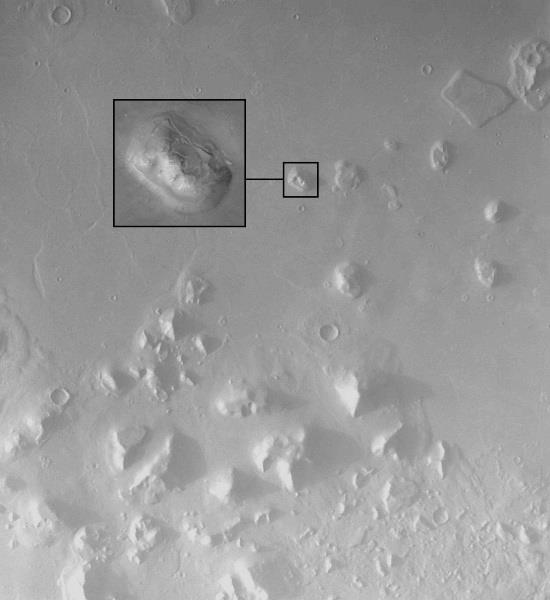
Hoagland claimed that NASA had more evidence, but was hiding it lest it cause the "collapse of human civilization." Some scientists cynically suggested that Hoagland, author of the book THE MONUMENTS OF MARS, was trying to provoke controversy to boost sales of his book, videotapes, speeches, and other materials. Hoagland, incidentally, also claimed that Phobos was artificial, that there are giant glass skyscrapers on the Moon, and that NASA was founded by Nazis.
The aerospace publication AVIATION WEEK mocked the effort to take the new image of the Face, suggesting that NASA might next propose a mission to find the Man in the Moon. This criticism seemed a bit silly in the other direction; as long as there was a probe in orbit around Mars, taking a picture of an interesting object seemed a reasonable act of curiosity, and at the heart of the reason we bothered to send it there. "Face" advocates pressured NASA for more observations, but the space agency and its collaborators simply pointed to the excellent detail of the MGS photograph, suggesting that those who didn't find it convincing wouldn't be convinced no matter what they got. Anybody wanting to inspect the "Cydonia Pyramid Complex" had plenty of new survey imagery that was far more detailed than the Viking pictures.
BACK_TO_TOP